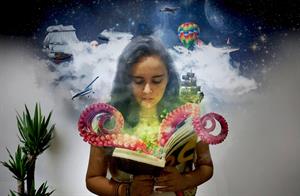PDF chapter test TRY NOW
Imagery as a poetic device refers to the usage of verbal images to describe a concept. An image is thus any vivid or picturesque phrase that evokes a particular sensation in the reader's mind.

A girl visualises the text she is reading
Imagery uses imaginative language to represent objects, actions, and ideas in such a way that it appeals to our physical senses. A writer helps the reader to visualise or to see in their minds what is being described. The poem is said to have imagery if it describes senses such as the sight, sound, smell, taste, and/or feel of something. As a result, the images should appeal to one or more of the five sensory organs: eyes, ears, nose, tongue, or skin.
Imagery helps the readers understand the literary work better. The concept is made easier to understand and remember as the readers are made to visualises it.
Example:
1.It was dark and dim that night.
The words “dark” and “dim” are visual images; (that appeal to our eyes).
The words “dark” and “dim” are visual images; (that appeal to our eyes).
2. The kids were screaming and laughing in the classroom.
“Screaming” and “laughing” appeal to our sense of hearing; (that appeal to our ears).
“Screaming” and “laughing” appeal to our sense of hearing; (that appeal to our ears).
3. Rani whiffed the fragrance of the fresh rose blossoms.
“Whiff” and “fragrance” evoke our sense of smell; (that appeal to our nose).
Imagery used in the poem "The River":
- O’er the yellow pebbles dancing — Sight
- Through the flowers and foliage glancing — Sight
- On you rush through rough and smooth — Sight, Touch
- Louder, faster, brawling, leaping — Sight, Sound
- Over rocks, by rose-banks, sweeping — Sight, Sound
- Seeming still, yet still in motion — Sight
- Down you dash into the sea — Sound, Sight
- Sea that line hath never sounded — Sound
